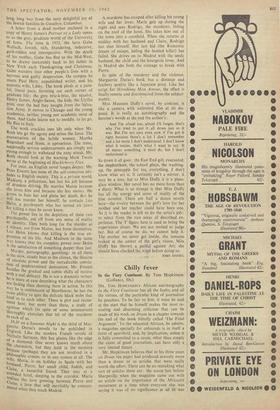Chilly Fever
In the Fiery Continent. By Tom Hopkinson. (Gollancz, 30s.) In the Fiery Continent. By Tom Hopkinson. (Gollancz, 30s.) MR. TOM HOPKINSON'S African autobiography In the Fiery Continent has all the faults, and all the virtues, of the particular kind of journalism he practises. To be fair to him, it must be said at the start that he himself makes the most re- vealing and disarming criticism that can be made of his work on Drum in a chapter towards the end of the book bitterly called 'The Final Argument.' To the educated African, he admits, a magazine specially for coloureds is in itself a form of apartheid, and, by implication, unless it is fully committed to a cause, other than simply the cause of good journalism, can have only a very limited future.
Mr..Hopkinson believes that in his three years on Drum the paper had produced scarcely more than a dozen or so articles that were really worth the effort. There can be no mistaking what sort of articles these are: the scoop just before Sharpeville when the magazine came out with an article on the importance of the Africanist movement at a time when everyone else was saying it was of no significance at all (it was
the response to the Africanists' call to the people to assemble outside the police stations that led to the shootings); 'Inside Pondoland' (where African resistance to the Bantu Education Act was at its bloodiest); Chief Awolowo writing about Nigeria and Julius Nyerere on a new Federation; and the photographs of the Congo fighting and the horror in Angola (those of Sharpeville, like the famous Sharpeville article, had to be published abroad). Apart from this, and a brilliant column of African town-life stories by Casey Motsisi, whom Hopkinson spotted at sight, the magazine continued much as it was, or much like the old Picture Post, with short readers' letters followed by short edi- torial comments, Priscilla answers your love problems (with a moral code that could be taken straight from Evelyn Home) and pictures of African beauties (mostly light-skinned) on the cover. Hopkinson finally resigned because the proprietor said the paper could not bear the initial losses that would be involved in building up Central and East African editions where a magazine for coloureds was really needed, and because he was ordered to drop the political ar- ticles and go in for more sensationalism—i.e., the same style but different subjects. It was largely a business quarrel and from his tone Hop- kinson seemed to act as if the management did not exist. He needed, understandably, to be owner and editor at once.
What then, if this had been the case, could Hopkinson have done? He could in the first place have made an even more valuable con- tribution to the training of African journalists and photographers and probably made sure that his magazine contained the best picture-report- ing of its kind. Yet how valuable is its kind? Do people really think, for instance, that this
country is the worse off for having no national Paris-Match or Der Spiegel? The trouble with this acid, neutral, supposedly objective reporting, for which Hopkinson was by nature particularly suited, is that it has no political language of its own; it equates pop-singers with politicians, for it has really no preference for either, no sense of priorities. However punchy or familiar the style, in the end it is cold and impersonal. The failing of journalism is not now coverage, but leader- writing; what is lacking is not the sensational article with pictures, but thought. Articles isolate, but leaders can direct and influence. There are few enough of this kind of leader being written in this country; is there really a case for ex- tending abroad the sophisticated kind of cushion- ing Town coverage that is popular here? The need is for more Tom Paines and a great deal less Panorama.
This said, it has to be admitted that Hopkin- son has the knack of describing what happened to him brightly and well, and the knack also of being in the right place at the right time. His book certainly reads, if it doesn't actually photo- graph, and anyone who wants to know what it felt like driving and begging lifts in the Congo, with a riot or a charred-out jeep round every corner, need look no further.
MALCOLM RUTHERFORD







































 Previous page
Previous page